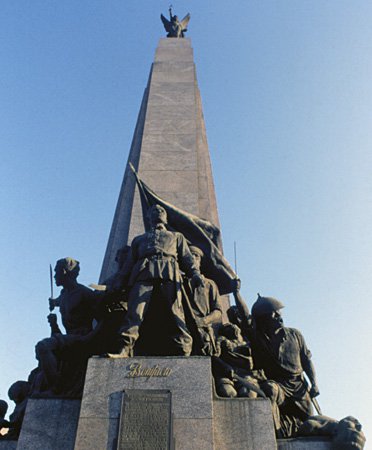Cultural Center of the Philippines
ENCYCLOPEDIA OF
PHILIPPINE ART
Bonifacio Monument / Monumento
1933 / Bronze / Artist: Guillermo Tolentino / Caloocan City
Bonifacio Monument, which won first prize in a contest sponsored by the National Museum in 1930, is a group sculpture of numerous figures massed around a central obelisk. The principal figure is Andres Bonifacio, leader of the 1896 Philippine Revolution. Behind him and beneath the flag stands Emilio Jacinto. On both sides the Katipunero brandish their bolo in a call to arms. Behind the figure of Bonifacio, at the opposite side of the obelisk, are the hooded figures of the three martyred priests Mariano Gomez, Jose Burgos, and Jacinto Zamora, whose execution gave birth to nationalism. These are followed in sequence by the initiation rites into the revolutionary secret society of the Katipunan, a dying woman with an infant reaching for her breast, and the man with clenched fist upraised beside the Katipunero figure, which completes the movement back to Bonifacio.
Bonifacio himself stands with pistol and bolo in each hand, his figure expressive of nobility and resoluteness of purpose as he surveys the scene. Classical ideals come into play, particularly in the restrained approach to the Bonifacio figure, but so does romanticism in the emotional dynamism of the Katipunero. Not to be overlooked is the realist’s concern for detail, especially since Tolentino was also an excellent portraitist. Through these various strands, what comes to the fore is the sculptor’s genuine feeling for the subject. The figure of Bonifacio, the tragic revolutionary hero, was an inspiration to the artist as nationalist. This monument, which marked the apex of Tolentino’s career, was completed on the eve of the founding of the Commonwealth, once more stirring hopes for independence from colonial rule, symbolized by the winged victory atop the obelisk.
Written by Alice G. Guillermo (1994)
